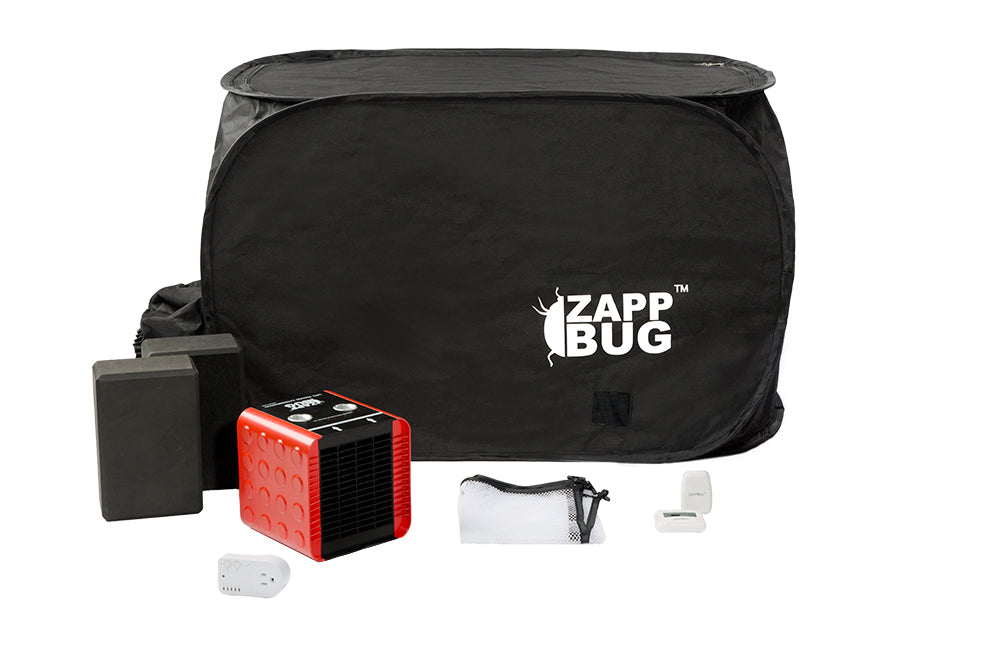STEP #4: KILL BED BUGS WITH DIATOMACEOUS EARTH
Diatomaceous earth (DE for short) is an extremely helpful tool in both eradicating bed bugs and proofing a home against re-infestation.
Disclaimer: Diatomaceous Earth should not be inhaled. Please consult the MSDS before using diatomaceous earth:MSDS version one, MSDS version two, and consult any instructions provided by the supplier of diatomaceous earth. Always be careful when applying diatomaceous earth. If you have any concerns consult with a physician before applying diatomaceous earth. Always avoid pool grade diatomaceous earth.
What is Diatomaceous earth?
▪ WORKS GREAT WITH HEAT TREATMENT: Diatomaceous earth is a great tool to use on your residence as you heat treat your items. It can be heat up itself, and can be placed on items that are awaiting heat treatment or that cannot be heat treated.
▪ KILLS: Diatomaceous earth is a desiccant, disrupting the waxy shell of bed bugs and making them more prone to eventual death by dehydration. It does not have any pesticides or other compounds.
▪ MECHANICAL BARRIER: It can also act as a physical barrier to bed bugs, meaning that they will avoid crawling through it.
▪ LONG LASTING BUT SLOW ACTING: While diatomaceous earth does not kill the bugs immediately (it can take 7 to 17 days) it does have long-lasting, effective results.
▪ PRECAUTIONS: You will want to wear a dust mask when spreading DE because getting any fine particulate matter in your lungs is not a good idea. To reduce the risk of inhaling particles make sure that the diatomaceous earth you are using is pesticide grade, not pool grade, and that it is just diatomaceous earth (without any insecticides added in).

ZAPPBUG
Buy Now
|
 ZAPPBUG
Buy Now
|

ZAPPBUG
Buy Now
|
HOW TO KILL BED BUGS WITH DIATOMACEOUS EARTH
Bed bugs can crawl through electrical conduits and live in wall voids, so you need to “cordon off” these areas with diatomaceous earth. We recommend using DE along with other methods for a comprehensive treatment protocol. DE works best in large furniture and around the rooms you are treating, so we recommend using heat treatment for all your smaller belongings.
STEP ONE
Pull Everything Away
From the Walls
This is to give you easy access to the areas you want to treat with diatomaceous earth. Heat treat loose objects then place in sealed containers until you’re done treating your infestation.
STEP TWO
Put Diatomaceous Earth Behind All Face Plates
You must put diatomaceous earth behind each electrical face plate and light switch face plate. For information on how to do this view the above video.
STEP THREE
Apply Diatomaceous Earth. to Area Where Wall Meets Floor
You want to work
diatomaceous earth into the crevice between the wall and floor. You also want to work
diatomaceous earth into the crevice where the molding meets the wall.
STEP FOUR
Apply Diatomaceous Earth Between Carpeting and Wall
We recommend heat treating any area rugs in a ZappBug unit and then storing in a sealed bag or tub until the infestation is eliminated. For wall-to-wall carpeting, work diatomaceous earth around the edges where the carpeting meets the wall.
Purchasing Diatomaceous Earth and helpful tools
▪ Any brand of diatomaceous earth will work, but we like Thomas Labs’ 3 lb Jar of Diatomaceous Earth because of the handy plastic jar it comes in. You will likely need more than 3 lbs, but a jar this size is easy to move around because it’s not too heavy and the convenient screw on lid is helpful as it’s tidier to have a jar with a lid, rather than rolling up the end of an open bag.
▪ When you buy diatomaceous earth in larger quantities the price per pound drops dramatically. Larger quantities of diatomaceous earth are a real bargain.
▪ For spreading a lot of diatomaceous earth over a wide area a pesticide duster is useful and reduces the risk of breathing in DE. It’s not absolutely necessary, but it is helpful. We do not have a strong recommendation on which pesticide duster to get.
▪ You can handle Diatomaceous Earth. However you will want to wear a dust mask to avoid inhaling any diatomaceous earth.
Additional Resources
▪ Virginia Tech Guide to Non-Chemical Bed Bug Treatment
▪ EPA Guide to Desiccants
▪ Baltimore City Bed Bug Guide – see step 9 for applying DE
Disclaimer: Some of the procedures outlined in this guide may be tricky and should be undertaken at the readers own risk. Readers should consult all material data sheets for any products they use in their own attempts at pest control and consult with the manufacturers of all products regarding best usage practices. This guide should be construed as theoretical advice. ZappBug and its employees will not be held responsible for any injury due to the advice offered herein. This guide cannot be construed as formal advice and ZappBug will not be held liable in any instance of an action resulting from this story. This disclaimer assigns the readers all responsibility for their own decisions.


